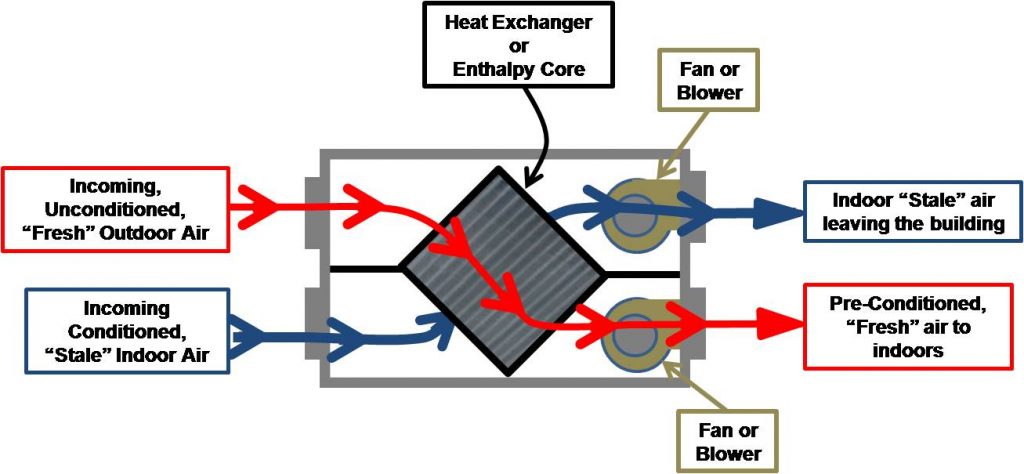
During summer and winter, your home HVAC system needs a backup to maintain total home comfort. The backup is a Heat Recovery Ventilator.
During winter, many of you are likely closing windows and doors to prevent heat from escaping. While in summer, we close the windows to keep the heat out while turning on the air conditioner.
In modern homes, it is often a challenge to ensure your home has good ventilation. The ideal solution to this common problem is the installation of a heat recovery ventilator.
If the word doesn’t mean a thing to you, it is high time you find out more about a heat recovery ventilator and how your home can benefit from it. A heat recovery ventilator system brings fresh air inside your home without allowing the heat to escape. If you are still clueless, read on.
Modern homes have much higher technical standards than homes and buildings built several decades back. They are often more energy-efficient due to their improved heat insulation. One central area of improvement was to create more airtight structures, so the heat generated by many HVAC systems stays inside for longer. However, it has a flaw: we need constant air changes to breathe healthy and clean air. Washing dishes, doing laundry, bathing, showering, drying clothes inside the house, and the simple act of breathing generate vast amounts of water indoors. Vaillant, a prominent ventilation manufacturer, published that we create as much as ten to 15 litres or equivalent to three to four gallons of moisture every day. If you don’t act on it soon, you’ll be surprised that your home will be full of mould, mildew and also dust mites not long after. If you have family members who have asthma, breathing this air can be deadly to them.
The best solution to this issue is opening the doors and windows so that fresh air can get in and moisture can go out. But what if it’s winter? All the heat will be lost, and you’ll be spending money on heating you don’t really benefit from. If your home is old and drafty, you no longer have to worry about ventilation. But again, your problem is that you’d likely freeze during winter since your home can’t hold onto the heat. Meanwhile, if your home is new and energy-efficient, the draft will no longer be an issue, yet it may be stuffy and not properly ventilated.
Now, let’s take inspiration from nature to fix this problem. Let’s consider our bodies as our homes. Our nose facilitates heat exchange every time we breathe by filtering the incoming air. Hence, your body can retain much-needed heat energy.
Now, let’s analyze further what a heat ventilator is.
(Photo: the way an HRV operates. The hot and moist air from inside (passes by the yellow duct) transfers all its heat as it passes through the heat exchanger before going out of the house. The cold and dry air flowing over the brown duct absorbs this heat on its way in. Thus, virtually no heat is lost.)
A heat recovery ventilator acts like a human nose. It has a couple of ventilation ducts running side by side between the interior and the exterior of a home. One of the ducts carries cool and fresh air going inside the house while the other one carries the moist and stale air going outside the house. They both pass the heat exchanger, allowing both ducts to transfer most of the heat to the air going in without both ducts ever getting into contact. There’s often a fan/ blower in every duct that you can either turn up or down automatically or manually depending on the humidity level and temperature. During summer, you can also fit a bypass to it so the cooler outside air can be directed straight indoor without meeting the air going outside (similar to opening a sash window).
Not all heat recovery ventilators work the same. There is an alternative system known as the energy recovery ventilation (ERV) that works similarly yet transfer a little bit of the moisture to the incoming air, maintaining the constant level of the humidity indoor. If you go green and live in an eco-home, an HRV works best alongside a heat pump or a solar energy system.
Having a heat recovery ventilator can provide you a warm and well-ventilated home. You can reduce heating costs during winter and minimize the need for air conditioning during summer. You can make sure the moisture stays out while keeping the indoor environment at a more constant level. Just bear in mind, though, that operating expenses will be slightly higher because of additional small fans to run on top of the installation fee. Regular maintenance is also a must, especially cleaning or changing its filters every six to twelve months.
If you can afford to have one at home, consider the benefits offered by a heat recovery ventilator and boost the comfort and convenience provided by your home HVAC system day in day out.
